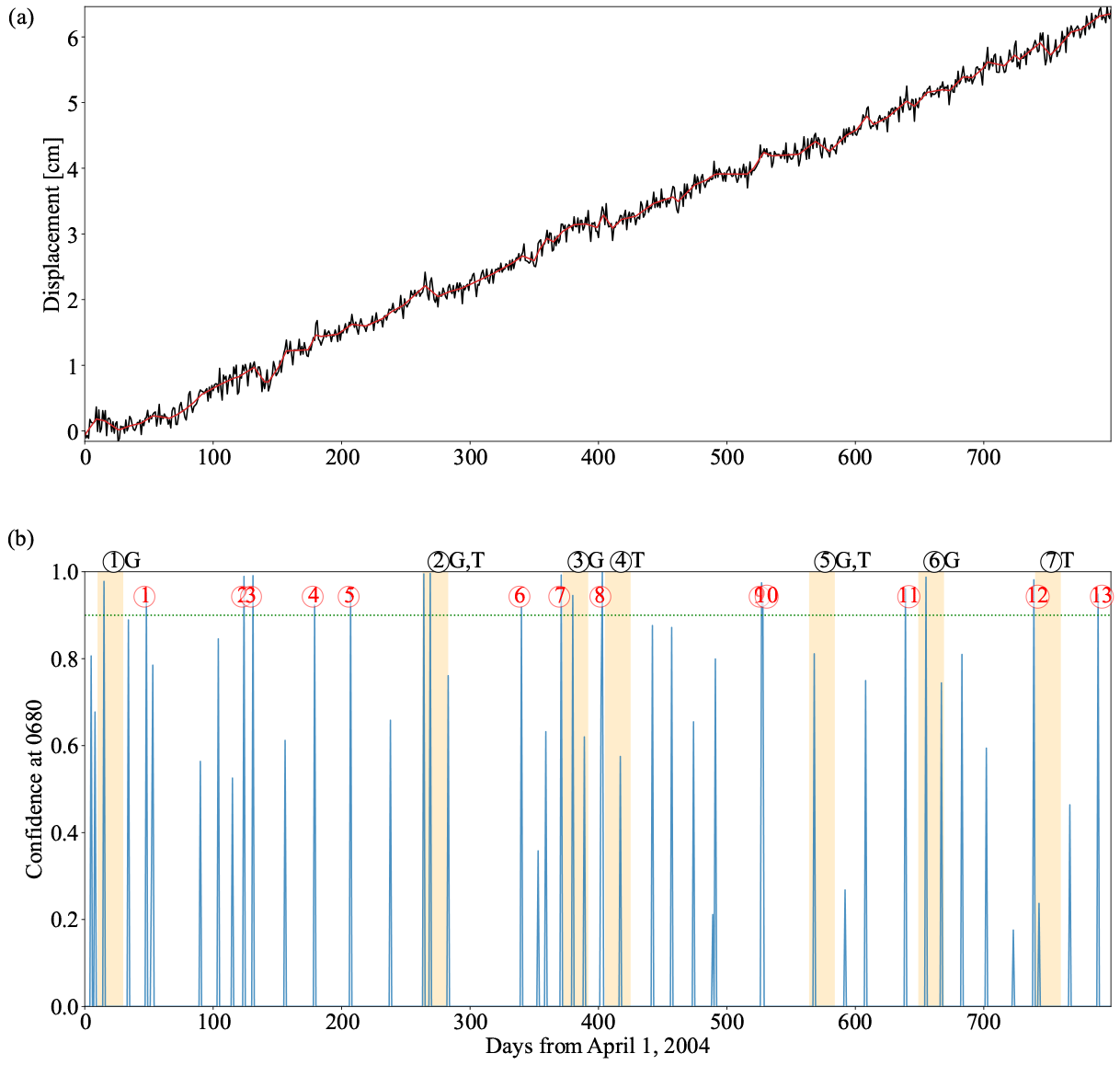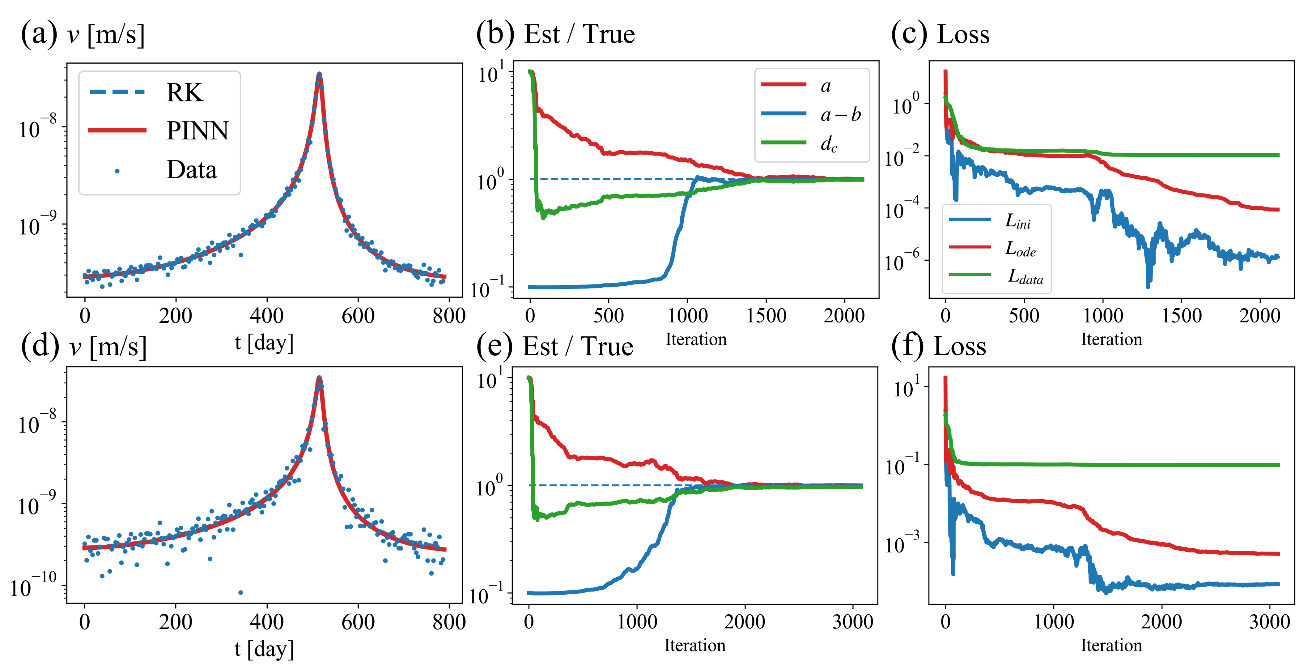成果物
1. l1トレンドフィルタリングによるスロースリップイベントの自動検出 (日本語)
Automated detection of slow slip events by l1 trend filtering (English)
説明: 通常の地震に比べてゆっくりとした断層破壊を特徴とするスロースリップイベントが、世界中のプレート境界で発見されています。スロースリップイベントの発見は巨大地震発生域を含む周辺の断層すべり現象の挙動の理解に不可欠です。数日程度の継続時間を持つ短期のスロースリップイベントは目視で検出できるほどの変位になることが少なく、高精度の自動検出手法が必要です。本プロジェクトでは、全地球衛星測位システム(GNSS)アレイを用いた短期スロースリップイベントの自動検出法を開発しました。開発手法は、l1トレンドフィルタリングと呼ばれるスパース推定技術とp値統合法を組み合わせて、イベントの候補時点だけでなく、検出の信頼度も提供します。詳細は下記の論文を参照いただき、プログラムは下記のリンクより入手ください。
Description: Slow-slip events, characterized by slower fault rupture compared to ordinary earthquakes, have been discovered in tectonic zones worldwide. The discovery of slow-slip events is essential to understanding the behavior of the fault-slip phenomena in the vicinity, including megathrust zones where large earthquakes occur. Short-term slow-slip events with a duration of a few days rarely result in sufficient displacement to be detected visually, so a refined automated detection method is required. In this project, we developed an automatic detection method for short-term slow-slip events using the Global Navigation Satellite System (GNSS) array. The developed method combines a sparse estimation technique called l1 trend filtering with a p-value integration method to provide not only candidate points in time for events, but also confidence in detection. For more information, please see the paper below and obtain the program from the link below.
手法の詳細(Details):Keisuke Yano and Masayuki Kano (2022) l1 Trend Filtering-based Detection of Short-term Slow Slip Events: Application to a GNSS Array in Southwest Japan, accepted at Journal of Geophysical Research: Solid Earth
プログラムのリンク (Program):https://github.com/star-e-tohoku/ssedetection
フィルタリングとイベント検知の例 (Example of filtering and event detection)

2. 物理深層学習の断層すべり計算への適用:ばねブロックモデルにおけるSSE数値計算・摩擦特性推定・すべり予測 (日本語)
Physics-Informed Neural Networks for Fault Slip Monitoring: Simulation, Frictional Parameter Estimation, and Prediction on Slow Slip Events in a Spring-Slider System (English)
説明: 通常の地震に比べゆっくりとしたすべり速度と長い継続時間を持つスロースリップイベント (Slow Slip Event: SSE)が多くの沈み込み帯で観測されています。SSEは巨大地震が発生する可能性のある領域に隣接して発生し、巨大地震発生メカニズムの理解のためにSSEのモニタリングが重要です。地震とSSEは異なる摩擦特性に基づく断層すべり現象としてモデル化でき、断層すべりの物理モデルと地殻変動観測からこの摩擦特性の推定が可能です。本プロジェクトでは、深層学習を用いた断層すべりモニタリングのための新たな手法を提案しました。物理法則と観測データを同時に学習することができる物理深層学習 (Physics-Informed Neural Networks: PINNs)を用い、すべり計算(順問題)・摩擦特性推定(逆問題)・すべり予測(順問題と逆問題の融合)を試み、もっとも単純な断層すべりモデルであるばねブロックモデルにおけるSSEを対象として検証を行いました。結果、断層すべり計算・模擬観測データからの摩擦特性推定・断層すべり予測に成功し、断層すべりモニタリングにおけるPINNsの有効性が明らかになりました。詳細は下記の論文を参照いただき、プログラムは下記のリンクより入手ください。
Description: Slow slip events (SSEs), which are fault slips characterized by slower velocity and longer duration compared to earthquakes, have been observed in many subduction zones. Monitoring SSEs is important for understanding large earthquakes because they occur adjacent to areas where significant earthquakes could potentially occur. Different types of fault slips, including SSEs and earthquakes, can be explained by distinct frictional properties on the fault. These frictional properties can be estimated from physical laws of fault slip and observed crustal deformation. In this project, we propose a new machine-learning based approach for fault slip monitoring. We employed Physics-Informed Neural Networks (PINNs), which simultaneously learn the physical laws and data, to simulate fault slip, estimate the frictional parameters, and predict subsequent fault slip. As a first step, we utilized a single-degree-of-freedom spring-slider system, which is the simplest physical model to simulate SSEs. We successfully simulated SSEs, estimated frictional properties from synthetic observation data, and discussed the potential for fault slip prediction. Our results suggest the significant potential of PINNs for fault slip monitoring. For more information, please see the paper below and obtain the program from the link below.
手法の詳細(Details):Fukushima, R., Kano, M., & Hirahara, K. (2023). Physics-informed neural networks for fault slip monitoring: Simulation, frictional parameter estimation, and prediction on slow slip events in a spring-slider system. Journal of Geophysical Research: Solid Earth, 128, e2023JB027384. https://doi.org/10.1029/2023JB027384
プログラムのリンク (Program):https://doi.org/10.5281/zenodo.8405977
物理深層学習による摩擦パラメータ推定の例 (Example of the frictional parameter estimation by Physics-Informed Neural Networks, figure from Fukushima et al. 2023)








